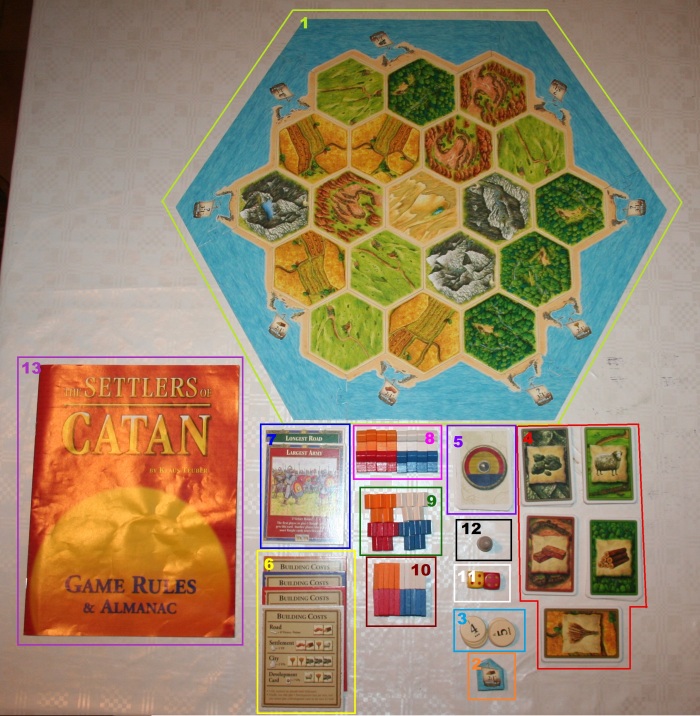Year of Publication: 1997
In The Beginning…
Was the island of Catan, and on that island small groups of people settled and expanded, becoming farmers, miners, shepherds and lumberjacks. However, the island proved to be too small to sustain multiple civilizations, so some of the people took to the seas to find new places to settle, and they became known as the Seafarers of Catan!
Okay, these Catan posts are going to be a little different to the normal reviews; as I’ve already done a full review post on the original Settlers of Catan I’m not going to do the “What’s In The Box” photos for any of the expansions or extensions, but instead only for the spin-off editions, like Starfarers of Catan or Star Trek Catan as those games are very different to the original. Instead all I’m going to do in these posts is to say which pieces are added to the base game to play the expansion and then review the differences in game play and give my opinion. All clear? Excellent! Without further ado:
What’s New?
Seafarers is obviously set over multiple islands, so each colour player is provided with 15 ships of their colour, which can be built by spending one sheep and one wood resource cards on your turn, and can then be used to travel to new places.
In addition to those the expansion also includes a large number of sea hexes and extra sea edge pieces to make the board bigger. Because several islands are involved in playing this game there are extra Catan Chits, with numbers on them to produce resources. There is also the new resource of gold, which allows a player who has a settlement built on one to claim one resource of their choice every time its number is rolled.
In original Catan each settlement gains a player one victory point, and a city is worth two. In Seafarers you get a bonus victory point for the first settlement you build that’s not on your original island, which is quite exciting. There are a few additional tiles that you put underneath such settlements so you don’t forget those points.
Lastly, in addition to the robber who lives in the desert, there is now also a pirate ship, which, obviously, lives in the sea.
Playing The Game:
As you can see from the above pictures, the way players begin the game is exactly the same as in the original Catan game, each player starts with 2 settlements, each with a road attached, and takes resources from one of those settlements to begin the game.
A players turn is exactly the same as in the original game; you roll the dice to claim resources (being wary of 7, which I’ll explain the differences of in a minute), then you build roads/settlements/cities/ships or development cards or trade for resources with other players and play development cards, and then you pass the dice to the next player, ending your turn.
Rolling Seven!
Rolling seven is the same as in the original Catan in that the player who rolls seven gets to move the robber, and can take a resource from any player effected by where they move it to. Additionally any player with seven or more cards in their hand still has to discard half of them (the lesser half in the case of an odd number, i.e. if I have 9 cards with a seven is rolled I must discard 4).
BUT!
In the Seafarers version of Catan the player who rolls the seven has the choice of moving either the robber, or the pirate ship. The pirate ship works slightly differently to the robber – the robber prevents resources from being harvested in the hex it’s on, but doesn’t do anything else. The pirate ship however has to stay in the sea, and so, instead of preventing resource production, it prevents a player from building new ships that would sit on any of the sides of the hex it’s on.

As you can see, in this picture the pirate ship has been moved onto a hex that the orange player (me) is currently trying to sail through. However, until the the pirate ship was moved I could not build any more ships there.
Game play proceeds in the normal way; each player tries to build settlements, roads, cities and development cards in order to collect the required number of Victory Points – in this edition 13 – to win the game.

The winning player is the first to reach 13 Victory Points and the game ends immediately when that happens.
Strategy:
I would say that getting to the coast is key in this game; with the addition of ships the possibility to extend your road is literally doubled and the extra Victory Points gained both from having the longest road, and from building settlements on new islands are valuable. The winning player when we played had a combination of luck (good dice rolls gaining him lots of resources), settlements upgraded to cities, the longest road, development card Victory Points and settlements on a new island – so literally every possibility in the game!
Also, if one player is in a much better position to win than the others, feel free to make an agreement with the other players to not trade any resources with them, there’s no shame in sabotaging someone else’s chances to further your own cause!
In Conclusion:
This expansion is, in my opinion, worth buying, as gives that little bit extra to the basic game, making it more interesting. This game also has many different scenarios, some of which I may write short reviews of over the coming year, which gives it more diversity than the original version, which can be altered, but not drastically.
I recommend this game as an excellent family game, and good for both board game nerds and board game likers who aren’t ready for anything more intense.










